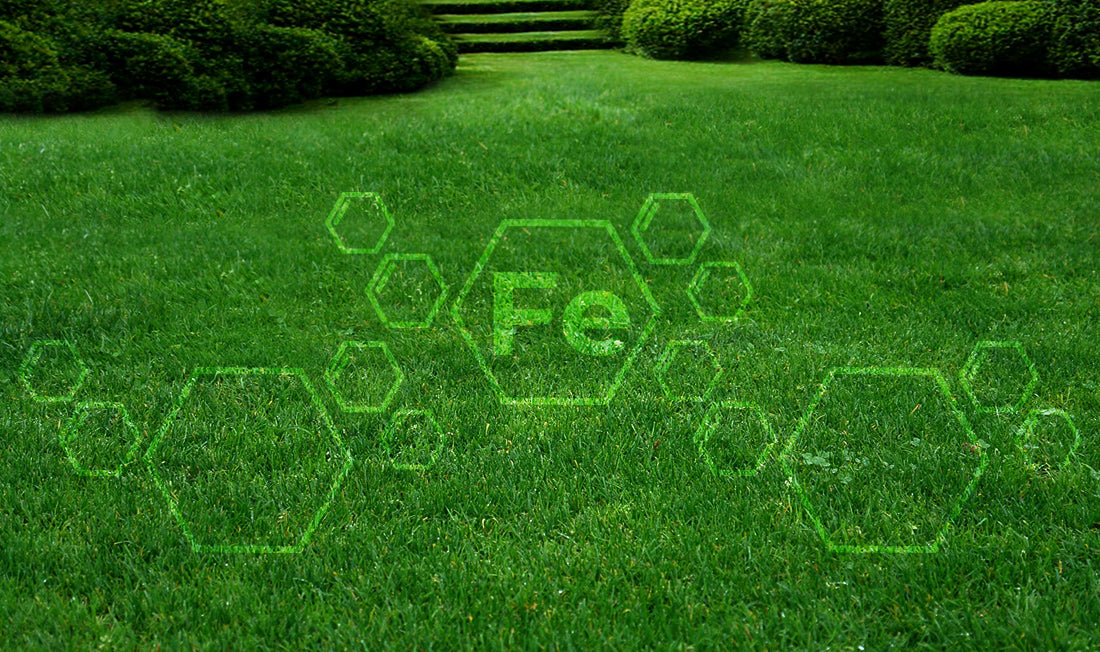Whether you’re a full-fledged lawn nerd or just starting out, there’s a good chance that you’re aware of the deep, dark greening effect that iron fertilization can have on a deficient lawn. This greening effect comes from the increased production of chlorophyll inside your lawn’s chloroplasts. But did you know that the chlorophyll molecule doesn’t actually contain any iron? The central elements contained in chlorophyll are actually magnesium and nitrogen. So then how exactly does iron fertilization make your lawn greener? What is iron doing for your grass, in general?
What Does Iron do for Grass?
Iron has many essential functions within plants such as being a constituent of electron transport chains and many vital enzymes. As far as the greening response of iron goes, we know that iron doesn’t help make up the actual structure of chlorophyll, however, its big role is still related to chlorophyll and chloroplasts. The synthesis of chlorophyll and the structure and function of chloroplasts are both dependent on iron. Iron is a part of ferredoxin which donates electrons necessary for chlorophyll biosynthesis.

One way to think of iron’s role is to visualize an assembly line being used to construct chlorophyll molecules. Iron would not be included in any of the ingredients that actually make up our chlorophyll, instead, it could be considered part of the actual assembly line which is making the chlorophyll molecules, like an employee, mediating the assembly of chlorophyll.
As an integral part of the “chlorophyll assembly line,” any changes in iron availability result in changes to the potential amount of chlorophyll that can be formed. In a lawn with plenty of assembly lines pumping out just the right amount of chlorophyll, adding some extra workers to the assembly line, might not make that much of a difference in terms of actually increasing chlorophyll production. This scenario represents a lawn functioning in perfect harmony, with balanced iron availability and iron utilization. This is why you may not notice any difference in your lawn after iron fertilization. If the iron in your plant matches your plant’s growth potential, then adding extra iron will not result in a greener plant.
But imagine a plant growing so quickly that its need for iron can’t be met. Maybe some workers in our chlorophyll factory called in sick, all on the same day (bad sushi from the night before?). Two things can happen, chlorophyll production will, at the very least, be compromised and less overall chlorophyll will be produced. Or, some assembly lines may need to shut down altogether, if the shortage of workers is bad enough. This represents a plant with iron deficiency. Here is where adding some iron to your soil or directly to the plant, via foliar fertilization, will help boost dwindling chlorophyll production as we bolster our assembly line with essential iron.

The Best Iron Fertilizers for Lawn
Has your lawn been looking a little yellow or pale lately? It could be an iron deficiency, Iron deficiency is even more likely if you have high-pH soil. Foliar fertilization with iron is a great way to bypass the soil and deliver iron right to the leaves of your lawn. Try fertilizing with Lawn Energizer or Darker Green. These products have the iron necessary to promote chlorophyll production, necessary for that deep-green lawn. Remember in order to make a foliar application of iron, skip the “watering-in” part for at least 24 hours. This means making sure it won’t rain immediately after you apply it and that your lawn has enough water to get it through until your next irrigation cycle. Also, avoid applying during the heat of the day, and be sure to check out our other lawn care blogs for more info to satisfy your lawn nerdiness.









